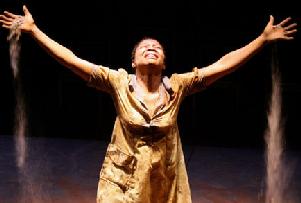SITE GUIDE
SEARCH
REVIEWS
REVIEW ARCHIVES
ADVERTISING AT CURTAINUP
FEATURES
NEWS
Etcetera and
Short Term Listings
LISTINGS
Broadway
Off-Broadway
NYC Restaurants
BOOKS and CDs
OTHER PLACES
Berkshires
London
California
New Jersey
DC
Philadelphia
Elsewhere
QUOTES
TKTS
PLAYWRIGHTS' ALBUMS
LETTERS TO EDITOR
FILM
LINKS
MISCELLANEOUS
Free Updates
Masthead
Writing for Us
A CurtainUp  London Review
London Review
 London Review
London ReviewMolora
|
Here lies my husband, made a corpse by this right hand: a masterpiece of justice. What's done is done.—Klytemnestra
|

Jabulile Tshabalala as Elektra
(Photo: Christian Enger) |
In Molora , the South African director Yael Farber who was responsible for 2004's hit Amajuba , turns to Greek Tragedy. Based on Aeschylus' Oresteia but also incorporating elements from Sophocles' Electra, this version relocates the ancient myth to contemporary South Africa, exploring its themes of revenge and forgiveness with special relevance to the establishment of democracy in the 1990s and the appeasement of avenging anger after the abuses of a white minority.
Mainly following the action of the trilogy's middle play, the Choephoroe, Agamemnon's murder at the hands of his unfaithful wife (Dorothy Ann Gould) is recounted as a past event. Their grieving daughter Elektra (Jabulile Tshabalala) is now trapped at home under Klytemnestra's indomitable tyranny but determined to exact vengeance on her murderous mother. Her brother Orestes (Sandile Matsheni), who was smuggled away as an infant, is now grown up and fully capable of executing this revenge. Instead of long Aeschylean monologues or choral odes, the narrative and back-story are portrayed via interwoven sequences and live graphic brilliance. For example, Klytemnestra's dream that she gives birth to a snake who suckles blood from her breast, fuelled both by guilt and prophecy prior to Orestes' return, is gruesomely acted out onstage. A sand pile representing Agamemnon's tomb is central to the stage throughout, around which the action revolves both physically and figuratively. In this way, the audience share a strong sense of this primeval tragedy's viscerality.
Adding to the production's earthy, primitive feel are the chorus of rural Xhosa tribeswomen who provide traditional "split tone" singing with incredible vocal strains and texture. Permanently onstage, their role as a truth and reconciliation commission is hinted at and they become the perfect observers and jury of the action.
Key to this reimagining of the myth, the chorus represent the end of the curse on the house of Atreus. They intervene in the action (contrary to the convention of Attic tragedy) to prevent the matricide and they represent humanity's capacity for forgiveness by forming the committee which explores and absolves past crimes. Aeschylus' gods are thus replaced by this paradigm for humanity. In the Oresteia , the human solution (democratic legal justice) results in an impasse when the jury's votes are equally split and the goddess Athena only ends the curse by appeasing the Erinyes with promise of civic inclusion.
Molora, on the other hand, presents a more hopeful and generally humanistic resolution: the end to the self-perpetuating cycle of revenge lies in men's own ability to achieve reconciliation via forgiveness. This version conclusively answers questions which Aeschylus provocatively left unresolved. Nevertheless, it cannot be accused of self-complacency in view of its truthful inspiration: the successful establishment of peaceful democracy in South Africa.
My main caveat regarding this production is that the audience ideally need to know the original trilogy in some depth before fully appreciating this play. Uncomfortable in many places (including sequences of onstage tortures) and unafraid of using silences and pauses in action, this is a vivid, untamed production which is ultimately a paean to humanity in the midst of self-destructive violence.
|
MOLORA
Based on the Oresteia trilogy Adapted by Yael Farber Created and Directed by Yael Farber With: Dorothy Ann Gould, Jabulile Tshabalala, Sandile Matsheni, Nofenishala Mvotyo, Nogcinile Yekani, Nokhaya Mvotyo, Nopsaile Mvotyo, Nosomething Ntese, Tandiwe Lungisa, Tsolwana B Mpayipheli Set Design: Larry Leroux and Leigh Colombick Costume Design: Natalie Lundon and Johny Mathole Lighting: Paul Peyton Moffitt Instrument and Song Arrangements: The Ngqoko Cultural Group Running time: 105 minutes with no interval A Farber Foundry Production in association with Oxford Playhouse. Originally produced in association with The Market Theatre Box Office: 020 7638 8891 Booking to 19th April 2008 Reviewed by Charlotte Loveridge based on 9th April 2008 performance at the Pit Theatre, Barbican Centre, Silk Street, EC2Y 8DS (Tube: Barbican) |
|
London Theatre Tickets Lion King Tickets Billy Elliot Tickets Mighty Boosh Tickets Mamma Mia Tickets We Will Rock You Tickets Theatre Tickets |




